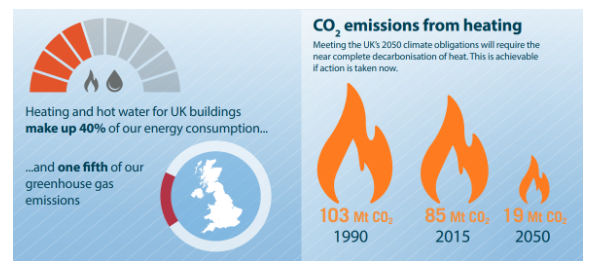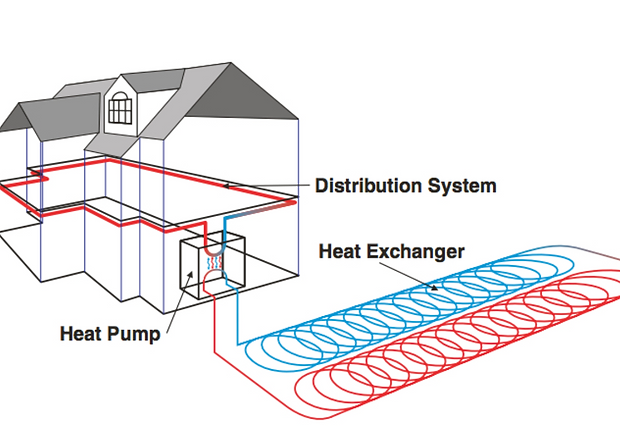
Heat Network Innovation



Pure energy is actively engaged in bringing low carbon heat networks to “Off-Grid” rural communities around the UK.
By Alan MacLeod, CEng MEI FRSA Founder and CEO, Pure energy (REGen) Ltd
“
Climate change impacts are disruptive, unpredictable, diverse and context dependent.
Heat pumps are widely recognised as a key clean energy technology that will play a critical role in the energy transition from fossil fuels to low carbon energy use. The low carbon heat pump market has expanded significantly, more than doubling in some EU countries in a single year.
A Ground Source Heat Pump offers low carbon space heating, cooling, and hot water, whilst producing approximately three times more energy than it consumes. Heat pumps transfer heat from the ground or water, a constant and renewable heat source, compressing and delivering heat to a building at the required temperature for both heating and domestic hot water production.
Climate change impacts are disruptive, unpredictable, diverse and context dependent. It is therefore not surprising that climate change adaptation activities and initiatives are many and varied. There are a number of core technologies which can be scaled-up to solve most of the challenges we currently face, with low carbon heat technology being one such promising solution.
In the UK, buildings produce nearly a fifth of all UK’s greenhouse gas emissions, with the majority coming directly from domestic properties. The UK government has legislated that we must reduce greenhouse gas emissions to net zero by 2050. This provides the legal imperative to decarbonise the heat sector, which in turn means the UK needs to eliminate almost all emissions currently produced by both heat and hot water consumption.
The energy efficiency of people’s homes, 85% of which are currently heated by natural gas, is a significant component to address in order to achieve the stated government targets for net-zero emissions by 2050.
In Scotland, with approximately 2.5 million homes, currently 11% have low emission heating systems installed.
The Scottish Government has set an interim target of converting one million homes and 50,000 non-domestic properties to green heat solutions, and a target for installation of 6TWh of heat networks by 2030. At the end of this decade, it is estimated that 200,000 heat pumps will be installed annually across Scotland.
For the rest of the UK, the potential contribution of heat networks to total heat demand by 2030 is estimated at 36 TWh, with the UK government estimating 600,000 heat pump installations per year by the same period.
Heat networks will be a core part of the pathway to decarbonising heat, through supply efficiency and fuel source. In the UK approximately 40% of our energy consumption and 20% of greenhouse gas emissions are due to heating and hot water supply for buildings, see Figure 1 below.

Heat pumps are a low-carbon heating technology with the potential to deliver large-scale reductions in carbon emissions from buildings, using electricity to transfer heat from ambient outside air, water or ground sources to a building’s interior. This process is highly efficient, with heat pumps delivering three to five units of heat for each unit of electricity needed to run them.
As much of the useful heat from heat pumps comes from inexhaustible environmental sources, 70–80% of energy provided by an average heat pump is renewable. When electricity used to power the electric compressor is produced from low-carbon sources, nearly all the useful heat provided becomes low or even zero carbon.

Over the last decade, costs of low carbon electricity have declined significantly, bolstering the case for electric heat pump deployment. Although further rapid growth now looks likely, the pace of adoption, and how that measures up against net-zero pathways, depends largely on both UK Government policy as well as future energy price trends. Recent increases in European gas prices directly increased the attraction of heat pumps when compared with gas boilers.
Heat pump costs comprise two main elements: capital costs and running costs. In general, heat pumps have higher upfront costs than fossil-fuel alternatives, and transition costs are particularly high for initial switch over from fossil-fuel systems to low carbon heat pumps.
“
Innovation is key to further heat pump deployment at scale…
Providing building owners with subsidies, for example through grant programmes, tax rebates or low interest loans, helps reduce these upfront costs. Increasing taxes on fossil fuels also reduces the cost differential regarding running costs.
The principal running cost (i.e., electricity usage) is directly related to supply cost, heat pump efficiency and overall building heat demand. Running costs are also reduced by improving energy efficiency of domestic properties. This aspect, when combined with increased heat pump technology performance, raises annual average coefficient of performance (CoP) from 3 to 4, resulting in an expected 20% running cost decrease, and importantly a competitive cost comparison with gas boiler usage.
It may be more economical to incorporate larger scale heat generation units to transfer heat to a number of properties, as opposed to each individual property, especially where heat generation requires high capital costs (e.g., ground arrays for heat pumps). This approach is more efficient in heat dense areas, where pipe lengths can be significantly reduced between properties.
Pure energy is currently working on a new heat pump package concept design, enabling properties to be connected to a ground source heating system in a simpler and more efficient way, providing a straightforward connection between the ground loop array and both the property domestic hot water (DHW) and heating circuits.
The proposed concept design provides a means of contributing directly to national CO2 reduction targets, makes the move from traditional fossil fuel based domestic heating systems more efficient, whilst decarbonising energy production and use within the home.
If heat pumps are to become mainstream, investment in consumer awareness, stronger initial subsidy support and innovative propositions and business models are urgently needed.
Maintaining the required annual growth rate of heat pump installations is the main challenge for the UK. It requires government policies to build confidence in low carbon technology in order to meet our stated climate goals.
Innovation is key to further heat pump deployment at scale, to maximise roll-out efficiencies and lower capital infrastructure costs.
Services (UK/International)
Technologies